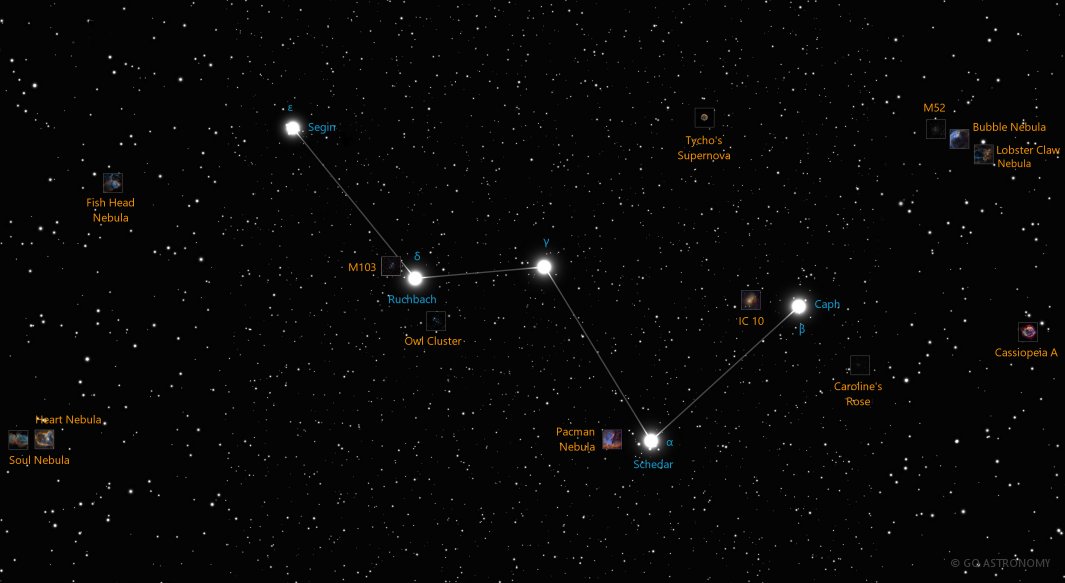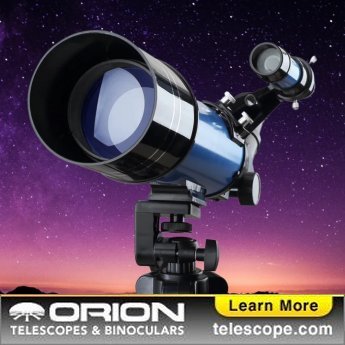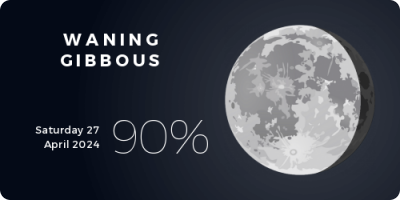Cassiopeia, the Mother of Andromeda (Cas)
(CASS-ee-uh-PEE-uh)
The Northern constellation of Cassiopeia, the Mother of Andromeda, is best viewed in Fall during the month of November.
Cassiopeia is the 25th largest constellation. It's brightest star is Schedar at magnitude 2.24. The boundary of the Cassiopeia constellation contains 14 stars that host known exoplanets.
Cassiopeia is a circumpolar constellation, so is visible year-round in the Northern hemisphere. Conversely, it is not visible in the opposite hemisphere.
- Pronunciation:
- CASS-ee-uh-PEE-uh
- Meaning:
- Mother of Andromeda
- Genitive:
- Cassiopeiae
- Abbreviation:
- Cas
- Constellation Family:
- Perseus
- Hemisphere:
- Northern
- Quadrant:
- NQ1
- Visibility:
- 90° N - 20° S
- Best viewing month*:
- November
- Area:
- 598 sq. degrees
- Size:
- 25th largest
- Circumpolar** (N=northern, S=southern):
- N circumpolar
- Right Ascension (avg):
- 0h 52m
- Declination (avg):
- 61°
- Meteor showers:
- Perseids
- Brightest star:
- Schedar (2.24)
- Stars with planets:
- 14
- X-ray stars:
- 3 (pulsars) stars
- Gamma-ray stars:
- 1 stars
- Caldwell objects:
- |
Brightest Stars in Cassiopeia
The 10 brightest stars in the constellation Cassiopeia by magnitude.
- Star
- Magnitude
- Spectral class
- Gamma Cassiopeiae (γ Cas)
- 2.15
- B0IV
- Alpha Cassiopeiae (α Cas)
- 2.24
- K0II-IIIvar
- Beta Cassiopeiae (β Cas)
- 2.28
- F2III-IV
- Delta Cassiopeiae (δ Cas)
- 2.68
- A5Vv SB
- Epsilon Cassiopeiae (ε Cas)
- 3.35
- B2pvar
- Eta Cassiopeiae (η Cas)
- 3.46
- G0V SB
- Zeta Cassiopeiae (ζ Cas)
- 3.69
- B2IV
- 50 Cassiopeiae (50 Cas)
- 3.95
- A2V
- Kappa Cassiopeiae (κ Cas)
- 4.17
- B1Ia
- Theta Cassiopeiae (θ Cas)
- 4.34
- A7Vvar
Double Stars in Cassiopeia
These are the brightest and easiest-to-find double, triple, and quadruple star systems in the constellation Cassiopeia. Also see all star clusters.
- Star system
- Magnitudes
- Type
- Eta Cassiopeiae
- 3.5, 7.4
- double
- Sigma Cassiopeiae
- 5.0, 7.2
- double
Star Clusters in Cassiopeia
The most notable and easy-to-find star clusters in the constellation Cassiopeia . Also see all star clusters.
- Star cluster
- Catalog #
- Cluster type
- Caroline's Rose
- open
- Messier 103
- M103
- open
- Messier 52
- M52
- open
- NGC 129
- open
- NGC 189
- open
- NGC 225
- open
- NGC 381
- open
- NGC 637
- open
- NGC 659
- open
- NGC 663
- open
- Owl Cluster
- C13
- open
Nebulae in Cassiopeia
Notable and easy-to-find nebulae in the constellation Cassiopeia . Also see all nebulae.
- Nebula name
- Catalog #
- Nebula type
- Bubble Nebula
- C11
- H II region
- Cassiopeia A
- supernova remnant
- Heart Nebula
- H II region
- Pacman Nebula
- H II region
- Soul Nebula
- emission
- Tycho's Supernova
- supernova remnant
- Fish Head Nebula
- emission
- Gamma Cassiopeia Nebula
- H II region
Galaxies in Cassiopeia
The most notable galaxies in the constellation Cassiopeia. Also see all galaxies.
Neutron Stars in Cassiopeia
These are the most well-known neutron stars in the constellation Cassiopeia. Although neutron stars cannot be seen in any amateur telescope, they are at the center of many supernova remnant nebulae, which can be seen. Also see all neutron stars.
The Queen of the Northern Sky
Cassiopeia is a constellation located in the northern hemisphere and is one of the 88 modern constellations recognized by the International Astronomical Union. Named after the vain queen in Greek mythology, Cassiopeia is easily identifiable for its distinctive 'W' shape formed by its five brightest stars.
Historical Overview
Cassiopeia is one of the 48 constellations listed by the 2nd-century astronomer Ptolemy and has been recognized throughout various cultures. Its mythology is tied to the Greek legend of Queen Cassiopeia, who boasted about her unrivaled beauty, angering Poseidon, who subsequently punished her by placing her in the sky, tied to her throne.
Location and Notable Features
Cassiopeia is located in the first quadrant of the northern hemisphere (NQ1) and can be observed at latitudes between +90? and -20?. It is bordered by Andromeda, Camelopardalis, Cepheus, Lacerta, and Perseus. It is also easily recognizable due to its proximity to the Big Dipper and Polaris, the North Star.
The constellation's five brightest stars form a characteristic 'W' or 'M' shape, depending on the observer's orientation. These stars are Schedar (Alpha Cassiopeiae), Caph (Beta Cassiopeiae), Gamma Cassiopeiae, Ruchbah (Delta Cassiopeiae), and Segin (Epsilon Cassiopeiae).
Deep Sky Objects
Despite its relatively small size, Cassiopeia houses several interesting deep-sky objects. Two of the most noteworthy open clusters are the Heart Nebula (IC 1805) and the Soul Nebula (IC 1848), both of which are emission nebulae about 7,500 light-years away.
Another remarkable deep-sky object in Cassiopeia is the Double Cluster (NGC 884 and NGC 869). This pair of open clusters is visible to the naked eye under optimal conditions and provides a stunning view in binoculars or a small telescope.
Observing Cassiopeia
Due to its location near the celestial pole, Cassiopeia is visible year-round from the Northern Hemisphere. From southern latitudes, it can be seen at certain times of the year low on the northern horizon. Its distinctive 'W' shape makes it relatively easy to locate in the night sky.
Due to the absence of extremely bright stars, Cassiopeia may be slightly challenging to observe in heavily light-polluted areas. However, in darker skies, its stars and deep-sky objects become much more accessible.
To find Cassiopeia, one method is to locate the Big Dipper, then follow the arc of the Dipper's handle away from the bowl until you reach Polaris, the North Star. Continue that line and you will reach Cassiopeia.
* Constellation shown for northen hemisphere skies. For the southern hemisphere, constellations appear rotated 180 degrees (upside-down and left-right reversed) from what is shown. Remember that seasons are reversed too - summer in northern latitudes is winter in southern latitudes.
** Circumpolar constellations are visible year-round in the hemisphere listed (and not at all in the opposite hemisphere).





